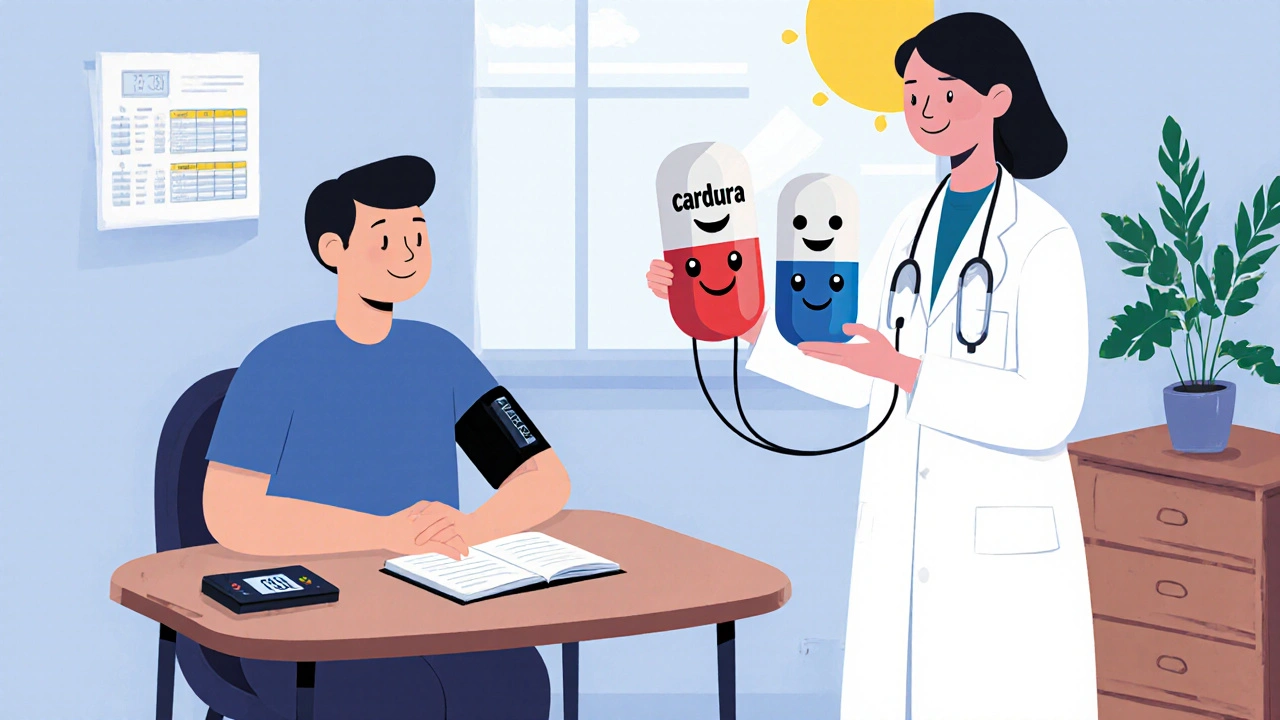Cardura (Doxazosin) vs Alternatives: A Practical Comparison

Medication Comparison Tool
Personalized Medication Selector
Answer a few questions to see which medication might work best for your specific needs.
Recommended Medications
Did you know that more than 30 million Americans take alpha‑blockers like Cardura - the brand name for doxazosin - to control blood pressure or ease prostate symptoms? If you’re wondering whether another pill might work better, stay tuned. This guide breaks down Cardura, looks at its most common rivals, and gives you the facts you need to pick the right option for you.
What is Cardura (Doxazosin) and How Does It Work?
Doxazosin belongs to the alpha‑1 adrenergic blocker class. By blocking alpha‑1 receptors on the smooth muscle lining of blood vessels, it relaxes those vessels, lowering peripheral resistance and thus blood pressure. The same mechanism also eases the muscle tone in the prostate and bladder neck, helping men with benign prostatic hyperplasia (BPH) urinate more comfortably.
Typical starting doses for hypertension are 1 mg once daily, often increased to 4-8 mg based on response. For BPH, doctors usually start at 1 mg and may go up to 8 mg. The drug’s long half‑life (about 22 hours) means once‑daily dosing is enough for most patients.
Why Compare Cardura with Other Medications?
Everyone’s body reacts differently. Some people feel dizzy on the first dose, others get a persistent cough, and a few experience swelling in the ankles. Knowing the trade‑offs of alternative drugs helps you and your clinician weigh benefits against side‑effects, cost, and any other health conditions you might have.
Key Alternatives to Cardura
Below are the most frequently considered substitutes. Each belongs to a different drug class, which means they work in distinct ways.
- Terazosin - another alpha‑1 blocker, marketed as Hytrin.
- Prazosin - a shorter‑acting alpha‑1 blocker, often used for nightmares in PTSD as well as hypertension.
- Lisinopril - an ACE inhibitor, a go‑to for many patients with high blood pressure.
- Amlodipine - a calcium‑channel blocker that relaxes arterial smooth muscle.
- Beta blockers (e.g., metoprolol) - reduce heart rate and contractility, lowering blood pressure.
Side‑Effect Profiles at a Glance
Every drug has a side‑effect fingerprint. Knowing which symptoms are common for each option helps you spot problems early.
| Drug (Brand) | Class | Typical Dose Range | Key Uses | Common Side‑Effects | Average Monthly Cost (US$) |
|---|---|---|---|---|---|
| Cardura (Doxazosin) | Alpha‑1 blocker | 1-8 mg | Hypertension, BPH | Dizziness, headache, edema | 30‑45 |
| Hytrin (Terazosin) | Alpha‑1 blocker | 1-10 mg | Hypertension, BPH | First‑dose syncope, fatigue | 28‑43 |
| Prazosin | Alpha‑1 blocker | 1-15 mg | Hypertension, PTSD nightmares | Orthostatic hypotension, palpitations | 25‑40 |
| Prinivil (Lisinopril) | ACE inhibitor | 5-40 mg | Hypertension, heart failure | Cough, elevated potassium | 15‑30 |
| Norvasc (Amlodipine) | Calcium‑channel blocker | 2.5-10 mg | Hypertension, angina | Swelling, flushing | 20‑35 |
| Metoprolol | Beta blocker | 25-200 mg | Hypertension, arrhythmia | Bradycardia, fatigue | 18‑32 |
When Might Cardura Be the Better Choice?
Consider Cardura if you need a single drug that tackles both high blood pressure and BPH without adding another pill. Its long half‑life offers stable 24‑hour control, which is handy for people who miss doses. If you’re already on a calcium‑channel blocker but still have urinary symptoms, swapping to or adding Cardura can address the prostate side‑effect without changing your blood‑pressure regimen.
Scenarios Where an Alternative May Shine
- First‑dose dizziness is a concern. Terazosin and prazosin tend to cause a more pronounced “first‑dose” drop in blood pressure. Starting low and taking the pill at bedtime can help, but some clinicians prefer ACE inhibitors like lisinopril for a smoother onset.
- Persistent cough. If you develop a dry cough on Cardura, an ACE inhibitor is actually more likely to cause cough, so switching to a calcium‑channel blocker (amlodipine) or a beta‑blocker may relieve that symptom.
- Kidney issues. Alpha‑blockers are generally safe, but ACE inhibitors need dose adjustments in chronic kidney disease. In such cases, a calcium‑channel blocker or beta‑blocker may be safer.
- Cost sensitivity. Generic lisinopril and amlodipine often cost less than branded alpha‑blockers. If price is a big factor, these alternatives can save you $10‑$20 per month.
- Multiple comorbidities. A patient with heart failure, hypertension, and BPH might benefit from a combination approach: Cardura for the prostate, plus an ACE inhibitor for heart failure, rather than relying on a single drug.

How to Talk to Your Doctor About Switching
Bring a list of your current meds, note any side‑effects you’ve noticed, and be ready to discuss your main health goals (e.g., “I want better blood‑pressure control without dizziness”). Ask these questions:
- What are the biggest pros and cons of staying on Cardura versus switching?
- Will an alternative interact with any other drugs I’m taking?
- How quickly will I notice changes after a switch?
- Is there a need for a “run‑in” period to monitor blood pressure?
Keep a short journal of blood‑pressure readings and any new symptoms for two weeks after any change. This data helps your clinician fine‑tune the regimen.
Quick Takeaways
- Cardura (doxazosin) is an alpha‑1 blocker that treats both hypertension and BPH.
- Alternatives include other alpha‑blockers (terazosin, prazosin) and drugs from different classes (lisinopril, amlodipine, beta blockers).
- Side‑effects differ: alpha‑blockers cause dizziness; ACE inhibitors may cough; calcium‑channel blockers can cause swelling.
- Cost, comorbidities, and personal tolerance should guide the choice.
- Always discuss any switch with a healthcare professional and track your response.
Frequently Asked Questions
Can I take Cardura with a beta blocker?
Yes, many doctors combine an alpha‑blocker like Cardura with a beta blocker to tackle blood pressure from two angles. The combo can lower heart rate and relax blood vessels, but you’ll need regular monitoring for low blood pressure.
What should I do if I feel dizzy after the first dose?
Take the first dose at bedtime and start with the lowest possible amount (usually 1 mg). If dizziness persists, call your doctor - they may adjust the dose or switch you to a gentler alternative.
Is Cardura safe for people with diabetes?
Generally, yes. Alpha‑blockers don’t affect blood‑sugar levels directly. However, if you’re on insulin or other meds that can cause low blood pressure, watch for signs of hypoglycemia combined with dizziness.
How does Cardura compare to lifestyle changes?
Medication works faster and more predictably than diet or exercise alone. Still, pairing Cardura with a low‑salt diet, regular activity, and weight control maximizes blood‑pressure control and can allow a lower drug dose.
Can Cardula cause erectile dysfunction?
Rarely. Some men report decreased libido or mild erectile issues, generally linked to low blood pressure rather than the drug itself. Talk to your doctor if it becomes a problem.

6 Comments
Cardura can be a solid choice if you need one pill for both hypertension and BPH. The long half‑life keeps blood pressure steady over 24 hours, which many patients appreciate. If you’re prone to dizziness, starting at 1 mg at bedtime can reduce that first‑dose drop. Always keep a log of your readings and side‑effects to discuss with your doctor.
Imagine swapping pills and feeling like you’ve unlocked a new level of wellness! Cardura’s dual action is like a superhero combo, tackling pressure and prostate in one go. Yet the alternatives each bring their own flair-ACE inhibitors whisper, calcium blockers roar. Choose the one that makes your daily routine feel like a victory dance.
One must contemplate, with due diligence, the philosophical underpinnings of our pharmacologic selections; Cardura, a molecule, is not merely a chemical, but a manifestation of our desire for control-over blood pressure, over urinary flow. Does the convenience of a single agent outweigh the nuanced side‑effect tapestry that each alternative weaves? Consider, for a moment, the ancient dictum: “Know thyself,” and apply it to your vascular system-know your tolerance for dizziness! The cost, the comorbidities, the very essence of your lifestyle-all converge in a single decision; a decision that demands reflection. In the grand theater of medicine, Cardura plays a lead role, yet supporting actors such as lisinopril and amlodipine deserve applause. Therefore, weigh, deliberate, and then-act!
Cardura’s place in the therapeutic hierarchy is not a matter of casual preference but a strategic battle for bodily sovereignty. When you line up the pharmacodynamics, the alpha‑1 blockade asserts dominance over vascular tone with ruthless efficiency. Its ability to simultaneously address BPH is a tactical advantage that many clinicians overlook in their myopic focus on numbers. However, the first‑dose orthostatic drop is a reminder that even powerful agents can betray the unsuspecting. This betrayal is amplified in patients with pre‑existing autonomic instability, where a sudden dip can precipitate falls. The alternative class, ACE inhibitors, cast a gentle spell on the renin‑angiotensin axis, avoiding the dizzying plunge. Yet they introduce a dry cough, a nuisance that can erode compliance faster than any price tag. Calcium‑channel blockers, on the other hand, offer a steady vasodilatory effect without the neurogenic shock, but they bring peripheral edema. Beta‑blockers suppress cardiac output in a manner that can be advantageous for arrhythmias, but they often leave patients fatigued. Cost considerations cannot be dismissed; generic lisinopril frequently undercuts Cardura by a sizable margin. For the financially strained, that dollar saving translates into better adherence and ultimately better outcomes. From a pathophysiological standpoint, if your primary goal is to tame both pressure spikes and urinary hesitancy, Cardura remains unrivaled. Yet the clinician must weigh renal function, electrolyte balance, and concomitant medications before crowning it king. In practice, a hybrid regimen-Cardura for BPH plus an ACE inhibitor for heart failure-often yields the most comprehensive coverage. Thus, the decision is less about choosing a single champion and more about orchestrating a symphony of agents that harmonize with your unique biology.
Combining Cardura with an ACE inhibitor works well for many patients. It targets both pressure spikes and prostate symptoms without overlapping side effects. Monitor blood pressure and potassium when you start both.
Don't trust pharma, they hide the real risks.